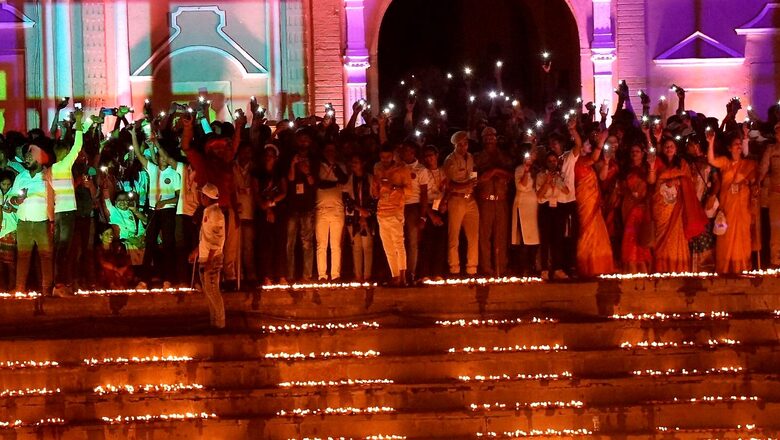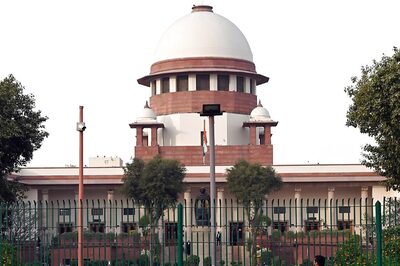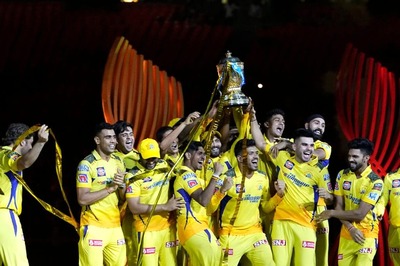
views
The subject of whether firecrackers are part of the Indian tradition for Diwali or not has been debated for long. People began to ask for the mention in Hindu texts and people began to respond too. But, after an introspection for three years I concluded that it is insane to look for a textual proof for each tradition. This conclusion came because many texts of ours got destroyed in the invasions — and many remain untranslated. The conclusion was also supported by the fact that Hindus aren’t “the people of the book”, and hence not every tradition needs to be mentioned in some or the other text. Neither a tradition of one region should match with the tradition of another region.
Bharat has been a land of diversity for diverse geography and geology. The central idea that unites Hindus is the virtue to have behaviour in accord with Ṛta, i.e., the cosmic law. And the process of holding (dhr-) that behaviour is called Dharma. This whole principle of diversity has been explained in this article, “How West, Middle East Gagged Freedom of Expression, and Why Women Were Excluded from Decision-Making,” and hence I’m refraining from going into the details here rather focus directly onto the subject. When you do that owing to respecting the Ṛta the traditions by default turn out to be different thereby enhancing a major diversity.
Firecrackers and festivals of light in ancient times
As far as the use of firecrackers in the form that they exist today is concerned, we find a little different mention in the texts of tradition available today with us although they indicate the use of the elements which do the same thing that the firecrackers do. Of course, with time the technology and engineering behind everything evolve. Today we all know that taps are the direct source of water to us, which doesn’t mean that people didn’t fetch water if the mention of tap doesn’t exist in the ancient texts. So now let us look at the texts of the past.
The Skanda Puran (2.4.9.65-66) talks of the tradition of observing Diwali holding Ulkas in our hands to show path to our departed ancestors (pitr). According to the translation of GV Tagare, Ulka is “firebrand.” There are various authorities in translations who mention Ulka as Firebrand, Torch, Meteor, Fire falling from sky. One of the best authorities on interpretation, Vachaspatyam, mentions Ulka as शुष्कतृणवस्त्रादिदीपिते (मशाल) इति प्रसिद्धे दीपभेदे which is “a kind of ‘dīpa’/lamp/flame (दीपभेद), known as मशाल (मशाल इति प्रसिद्धे), which is lighted (दीपित) using dry grass (शुष्कतृण), cloth (वस्त्र), etc (आदि).” The very well-known Indologist and Sanskrit expert of the early twentieth century V Raghavan has also explained it very well in his book Festivals, Sports and Pastimes Of India (page 162-170) that Ulkadan was done to the show the path to the ancestors (pitr) who have arrived during the Mahalaya.
The Ulka-Dan has been explained by him to be the firecrackers. He has also explained how the tradition of showing path to the ancestors is also observed in Mexico by the name “All Souls Day,” on 2 November, a date almost close to Diwali. In this observation people in Mexico, place lights at cemeteries, use firecrackers, make dolls representing ancestors and confections are cooked.
Raghavan mentions that although the firecrackers exploded in mid-air are intended to show the path to the ancestors, the purpose has also been catered traditionally by setting lamps atop high poles. This tradition is observed at the Panchganga Ghat in Banaras. In Bengal, the lamps are floated on water and this form of observation spread to far east and south-east Asia too. The lamps are floated in water in Thailand too and set atop poles as well. The tradition of floating lamp in Thailand is called, “Loi Krathong.” “Loi” means “to float” and “Krathhong” means a “leaf cup.” The cup is made of banana leaf in general, though a few people also make the lamp in the form of birds and boats. This tradition of Thailand is all about giving homage to Me Khong-kha, i.e. Mother Ganga; representing the waters (Essays on Thai Folklore, page 55).
Raghavan writes that although this is the popular explanation, this Thai tradition relates to similar lamps floating in Bengal and the rest of South-East Asian countries like Cambodia and Burma. The similar Cambodian tradition is an offering to departed ancestors and a ceremonial send-off to the ancestors after their visit to their descendants and partaking of the feast offered by them (like Hindu Sraddha). Even in China, a lantern festival is held on the first full moon-day. In Japan, specifically ancestor-worship occurs exactly as counterpart to Mahalaya and Diwali when once a year the ancestors make a visit to their old dwelling place and to help them, when they descend as well as ascend again, lights are placed on hills, lamps are lit all around, families flock to the cemeteries with lanterns in their hands or float them on the waters. This Japanese tradition is called Bon Matsuri. According to Japanese Festivals written by Helen Bauer and Sherwin John Carlquist the Japanese Tradition is very much similar to the Hindu tradition of Pinda-Dan where rice balls are offered to the spirits and like Hindu Tarpana names of ancestors are added to the lanterns before floating into the water.
Raghavan has also given a detailed account of observation of similar tradition in ancient Egypt. He talks about the ancient pagan festival of Candlemas (festival of lights) which was vehemently opposed by the early Christians but in vain and eventually adapted it with a Christian orientation. A similar festival known as Lemuria too existed among the Romans that observed honour to the lemures or ghosts of the dead who were devoid of kith and kin and had inadequate obsequial rites. Raghavan explains about the similar observation in Hindu-Tarpana too wherein we have a final water-libation to all those who have no kith and kin and similarly in the omnibus libations of the Mahdlaya season referred to above, we include a class of Pitrs called Kdrunyapitrs. In Nepal too along with Lakshmi Puja rice-balls (pindas) are offered to crows and dogs with the belief that ancestors come in those forms. In the Hindu tradition, the Shraddh is deemed to be gone well, if a crow takes the pinda. The dog is honoured for his association with Bhairava.
Coming back to the point of firecrackers, the Anand Ramayan talks of the use of firecracker making sky shine (gaganantarvirajitan) on Shri Ram’s arrival but the scholarly consensus places it in the 15th century, hence we can avoid using it as source to establish the use of firecracker as tradition. We have murals in Tyagaraja Mandir built in the 9th century that show the use of firecrackers very clearly.
We have many paintings from the medieval era showing Bhagwan Krishna celebrating Diwali with firecrackers. Often people assert that since they are from the medieval era and hence can’t be seen as a perfect source to establish the existence of firecrackers in Hindu tradition. But with a little application of logic we would understand that Hindus who actually resisted any kind of external imposition on tradition and fought wars for it would have accepted such portrayal of the Bhagwan had it not been rooted to some kind of tradition.
Firebrand to firecracker
It has been well established by Sanskrit scholars that Ulka meant a firebrand/ torch/ illumination in the sky. Hence, it clearly fulfils all functions of what a fuljhadi, rocket and other crackers of light do. Odisha observes the burning of Kaunriya (jute) Kathi which not only produced light but also the sound. Again, this fulfils all the definition of Ulka as described in Vachaspatyam and functions the way an archaic firecracker is supposed to. The moment you add saltpetre to these firebrands, they will turn into a firecracker. Notion was very clear. As per the tradition mentioned in the Skanda Puran, one was supposed to show the path to the ancestors (pitr) by firebrands that also produced sound.
Logically thinking, if one traces the origin of Saltpetre in the ancient period, it would be a bit too unwise to think that Indians won’t have added it to the firebrands. Firecrackers are nothing but an advanced technology for the firebrands.
Saltpetre use originated in India?
Let’s investigate the documents and sources. The existence of saltpetre has a long history independently both in India and China. The Arthashastra (a 4th century BC text) written by Chanakya talks about agniyoga (inflammable powder & explosives, page 181, 576) while discussing warfare.
We have an older Tamil Text (6th century BC) Bogar Ezhayiram (7,000 verses of Bogar), written by Boganathar. The verse 419, in the second set of 1,000 verses (of overall 7,000 verses), Boganathar mentions ingredients used for making distillations required for crafting Sarakku Vaippu. Sarakku Vaippu together indicate a specific type of compound created by the mixing of chemicals. Boganathar has emphasized the use of Saltpetre solutions for these. He refers to Saltpetre as white Vediuppu (i.e., Explosive salt). Vedi means explosion and Uppu means salt. In the verses 415-418, he has dealt with the method of preparation of the Saltpetre solution, Vediuppu Cheyaneer for all types of Sarakku Vaippu, of which fireworks include rocket powder, gunpowder etc., as types. The use of prefix Vedi, “explosive,” to the word salt, “Uppu,” distinguishes Vediuppu, (Saltpetre) from other salts for its explosive properties and they are named as:
• Black salt called Kariuppu, charcoal/ carbon containing salt
• Rock salt, referred to as madiyuppu or induppu, same as Senda Namak (Hindi) or Saindava Lavanam (Sanskrit)
Boganathar talks about adding Thurisu (crystals of bluish green copper sulphate) that is commonly used for dissolving corns in foot soles.
Anyone with knowledge of basic chemistry of explosives would be aware that the three ingredients: Potassium Nitrate, Sulphur and Charcoal or Sand are core for formation till today. The process mentioned by him from verses 414 to make explosives match to the description of Sir George Watt about the process followed by the organic Saltpetre manufacturers of Bihar and rest of India (refer The Imperial Gazetteer of India Volume III, page 153 onwards). This gives us a strong reason why Sivakasi became the stronghold for the firecracker production.
This is well established that India was aware about the tact to create explosives way before the supposed birth of Jesus of Nazareth.
Sir George Watt, writes with evidence in, “The Commercial Products of India,” published in 1908 that, “The term saltpetre (…) found in (…) chiefly South America, Spain, Persia, Hungary and India.” He makes no mention of China. The records show that Europeans had begun to manufacture Saltpetre only in India despite close ties with China. India continued to be the prime manufacturer of saltpetre. The record confirms that in 19th century, the United Kingdom, followed by the US and China were the largest importers of saltpetre from India. This is quite interesting to note as per the British records that the exports of Saltpetre from India touched its zenith valuing to more than 650,000 pounds during the American Civil Wars (1800-1860s). The record clearly shows that India held the monopoly for supply of saltpetre in that era.
Obviously, it happened in one blue moon rather India was always the base to the maximum potential to produce saltpetre. We also have the Chinese sources which themselves attribute the discovery of saltpetre in China to inspiration from India (Source: Technology in World Civilization, by Arnold Pacey & Francesca Bray, page 18).
I came across a very well researched paper by Dr Gustav Oppert, a German Indologist. He mentions that it is always safe to attribute India for having discovered saltpetre first. He writes: “No Chinese work on this question can, with respect to antiquity, be compared to Sukraniti, so that even if the Chinese should have independently invented gunpowder, the claim as to the priority of invention will certainly remain with India.”
Scientific logic to use firecrackers
After having known that the Hindu text does mention the phenomenon like the firecrackers and India being one of the primary sources for saltpetre it is bit too unwise to deny that firecrackers aren’t part of Hindu traditions.
Now that it is largely established that firecrackers are very much Indic in nature, let us focus on the scientific rationale behind using it. Bharat has always been an agrarian society by large with rice being the most staple food in most of the regions. In the months of autumn, appear “tiny leafhoppers” with an intense growth who feed on plant saplings thereby transmitting microorganism infecting plants. The records show that many species of leafhoppers are considered serious pests worldwide and, in many regions, they occur in large numbers leading to complete drying of crops. But even when their numbers aren’t large, they reduce the production of rice. One may like to refer to the book, “Insect Pests of Rice by MD Pathak and JR Khan,” to understand this issue. They not only affect rice but paddy crops too. If they aren’t controlled, they not only cause damage to crops but also spread various infectious flus in all living species including humans.
Hence in ancient times, as an immediate treatment Sulphur (Gandhak) was used to control these pests through the crackers. By using crackers, the sulphur was filled in the atmosphere in the form of gas to counter the pests. Modern research also shows that Sulphur is one of the most effective treatments for controlling such insects.
But do they add to the air pollution?
Undoubtedly, the use of firecrackers add to the pollution but the scale of addition to pollution is highly negligible and the same has been very well established by the detailed report by IIT-Kanpur which saw construction dust, vehicle, bad infrastructure as top three culprits in Delhi. Hence given the advantages and traditional values, this would indeed be a naïve step to bring a ban on firecrackers in one of the largest Hindu festivals of Diwali. It is indeed hypocrisy of administrations that though the ban is called upon by the harmless Hindu tradition of firecrackers, stubble burning, one of the major reasons behind declining air-quality of Delhi is not even given a consideration.
Conclusion
Even though my stand is clear that one need not have textual sanction to observe a tradition (reasons explained in the opening section), we have abundant sources to prove the presence of firecrackers in our traditions. It was a very scientific practice to fight the pests which harmed a lot of crops, and it certainly does not impact the environment even a percent to the amount of hue and cries that are made about it. The pause of any tradition is the first step towards annihilation of a civilisation and the states must get careful when dealing with such issues.
The writer is an architect and an author. The views expressed in this article are those of the author and do not represent the stand of this publication.
Read all the Latest Opinions here




















Comments
0 comment